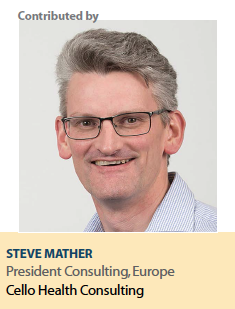Global markets have long held the promise of a rapid growth opportunity for the pharmaceutical industry, and indeed all forecasts continue to point to emerging markets being an engine of growth in volume and value of use of medicines. A closer look reveals that  uptake of innovative medicines will continue to be driven by the major markets, and while emerging markets are driving most growth, this will mainly be through increase in volume of generics and OTC medicines. Accessing the opportunity for innovation in emerging markets requires early opportunity analysis and a more localized approach, with careful evaluation of timing and scale of local resource, and balance in adaptation of global vs. local generation of evidence.
uptake of innovative medicines will continue to be driven by the major markets, and while emerging markets are driving most growth, this will mainly be through increase in volume of generics and OTC medicines. Accessing the opportunity for innovation in emerging markets requires early opportunity analysis and a more localized approach, with careful evaluation of timing and scale of local resource, and balance in adaptation of global vs. local generation of evidence.
The global pharmaceutical market in 2015 was worth about $950 billion. Forecasts for growth from the major data houses vary quite widely, with a mid-point of about 30% growth to around $1.4 trillion anticipated over the next five years. Growth is driven by emerging markets, innovation in specialty medicines, and generation of evidence to highlight improved long term outcomes and therefore justify spending.
The current share of the global pharmaceutical market is roughly 40% North America, 25% Europe, 20% Asia, and about 4% each for Japan and LATAM countries. While growth is forecast in all markets, it is the emerging markets that drive most growth.
A closer look, however, reveals that emerging markets being a major driver of growth gives only a partial view of the truth. Uptake of innovation will continue to depend on the major markets. A recent analysis of IMS data showed that almost 90% of sales of new medicines launched between 2010 and 2015 came from the G7 countries:
USA 58%
EU 5 23%
Japan 8%
Pharmerging* markets 2%
Rest of World 10%
* (Pharmerging markets: 21 countries identified by IMS as high-growth pharma markets, from the larger BRIC-M countries to others, including Kazakhstan, Nigeria, and Bangladesh)
Infrastructure and Affordable Medicines
While emerging markets represent significant growth over the foreseeable future, this will be driven by governments focusing efforts on improving infrastructure to allow improved access for the broad population to affordable medicines. Analysts estimate that 90% of volume growth in these markets over the next five years is anticipated to come from generics, non-original brands, and self-medication. Education, affordability, and infrastructure severely impact the opportunity for uptake of more innovative specialty medicines.
For those companies seeking to develop their business in emerging markets, they need to apply themselves to understanding the factors that will limit or drive success, typically rooted in:
The relative priority and awareness of the disease in local healthcare systems
State of infrastructure in local healthcare systems to make available and successfully use new technologies and medicines
Affordability – often linked to adherence
Success Drivers
A look across those companies achieving greatest success in uptake of innovative medicines indicates the following drivers:
A robust decision-making process feeding in early to development, supply chain, and commercialization plans, typically prior to Phase III programs being finalized. This is informed by early local opportunity analysis and understanding of local requirements (evidence, manufacturing, etc.) for regulatory approval and access that can be built into drug development programs. Early understanding of regulatory and payer needs and making early decisions on what local evidence will be generated within development programs can save several years in regional launch roll out and avoids frustrating and inefficient discussion when it is often too late to do much about it.
A shift from relying on force-fitting global evidence, strategy, pricing approach and communication platforms to a balance of global adaptation and local generation of evidence and leeway on strategy where the opportunity makes sense, supported by efficient decision making processes up the corporate organisation to ensure objectivity and avoid delay.
Careful consideration of timing and scale of resource deployment, typically driven early through regional platforms consisting of technically expert cross-functional teams with efforts focused on key countries. Regions are supported by a limited set of essential global initiatives and resource platforms for local adaptation, to allow effort by country commercial teams, once they are in place, to be focused efficiently on excellence in implementation relevant to the local market situation.
Close monitoring after launch to understand those programs and local initiatives that are driving fastest uptake, creating visibility and understanding through best practice sharing and rapid replication of these so called “lighthouse projects" across other countries. As the lifecycle develops, successful companies entrust greater flexibility to countries to choose which global initiatives to deploy and adapt according to the maturity of the market and the product’s place within it.
In conclusion, uptake and growth of innovative medicines will continue to be driven by the G7 markets, with success being determined by the ability to differentiate increasingly specialized medicines and back up the value proposition with compelling clinical and real-world evidence. Making the most of the relatively limited opportunity for innovative medicines in emerging markets depends on early opportunity analysis and decision-making, and organizational excellence in supporting the right balance between global adaptation and local leeway. (PV)
For more than 20 years, Cello Health Consulting has been supporting clients to solve complex commercial decisions, applying the right fusion of senior industry and consulting expertise to suit their unique situation, team, and goals.
For more information, visit cellohealth.com.










